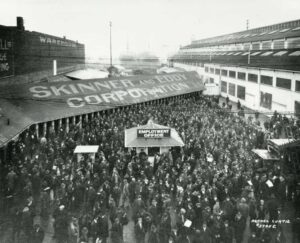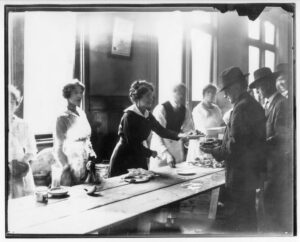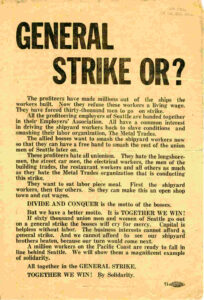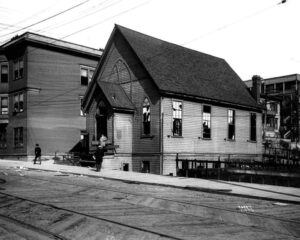Introduction to the Seattle General Strike
The Seattle General Strike was a city-wide work stoppage by more than 65,000 workers from February 6 to 11, 1919. 110 unions affiliated with the Seattle Labor Council—representing about 20% of Seattle’s population—went out on strike.
Importantly, the strike was supported in solidarity by large numbers of non-union members and non-wage workers as well. Women, children, and relatives of families with union members supported the strikers. Japanese American labor organizations—though excluded from membership in the largely white US labor movement at the time—chose to honor and participate in the strike alongside their fellow unionists.
Origins of the Strike
 The strike had its origins in the shipyards. During World War I, the government imposed wage freezes in war industries. At war’s end, shipyard unions demanded a raise. Additionally, the unions wanted to collectively bargain directly with their employers rather than through a federal board which mediated labor disputes during the war. Negotiations were complicated by this federal board, which discouraged Seattle employers from meeting the unions’ demands. The workers struck when the employers continually refused to meet their conditions.
The strike had its origins in the shipyards. During World War I, the government imposed wage freezes in war industries. At war’s end, shipyard unions demanded a raise. Additionally, the unions wanted to collectively bargain directly with their employers rather than through a federal board which mediated labor disputes during the war. Negotiations were complicated by this federal board, which discouraged Seattle employers from meeting the unions’ demands. The workers struck when the employers continually refused to meet their conditions.
Labor Feeds the People
 The strike lives in popular memory as a testament to the power of solidarity and direct action by working people. Though the scale of the strike panicked local and state officials who mobilized police and military personnel despite the strike’s non-violent character, the strike was administered peacefully and competently by the workers themselves. A strike committee administered the strike, making sure hospitals had sheets and babies had milk and—through a network of a dozen strike kitchens—the people of Seattle were fed. Diverse groups united across occupational, racial, ethnic, and gender divisions as well as political affiliations to assert themselves in a powerful eruption of collective action.The strike became a powerful model and source of inspiration for the labor movement in the United States and beyond. Later general strikes in San Francisco and Minneapolis St. Paul in 1934 and Oakland in 1946 looked to the Seattle General Strike as a model, drawing from the lessons it provided.
The strike lives in popular memory as a testament to the power of solidarity and direct action by working people. Though the scale of the strike panicked local and state officials who mobilized police and military personnel despite the strike’s non-violent character, the strike was administered peacefully and competently by the workers themselves. A strike committee administered the strike, making sure hospitals had sheets and babies had milk and—through a network of a dozen strike kitchens—the people of Seattle were fed. Diverse groups united across occupational, racial, ethnic, and gender divisions as well as political affiliations to assert themselves in a powerful eruption of collective action.The strike became a powerful model and source of inspiration for the labor movement in the United States and beyond. Later general strikes in San Francisco and Minneapolis St. Paul in 1934 and Oakland in 1946 looked to the Seattle General Strike as a model, drawing from the lessons it provided.
An Era of Transformation
 World War I and the post-war era was a time of social, political, economic, environmental, and cultural disruption, which contributed to and amplified labor turmoil in Seattle and the surrounding region prior to 1919. World War I itself, the influenza epidemic, Progressive Era infrastructure projects, massive population growth in the city, and the growing crises of capitalism led to increased worker discontent that culminated in the general strike. The workers—far from a monolithic group yet united in their demands—called for shipyard workers on the Puget Sound to be paid fairly.
World War I and the post-war era was a time of social, political, economic, environmental, and cultural disruption, which contributed to and amplified labor turmoil in Seattle and the surrounding region prior to 1919. World War I itself, the influenza epidemic, Progressive Era infrastructure projects, massive population growth in the city, and the growing crises of capitalism led to increased worker discontent that culminated in the general strike. The workers—far from a monolithic group yet united in their demands—called for shipyard workers on the Puget Sound to be paid fairly.
Politics of the Seattle Labor Movement and the Aftermath of the Strike
 Radicals in established unions and in the radical Industrial Workers of the World (IWW) agitated for a genuine revolution that called for the dismantling of the state. The IWW’s presence, the Bolshevik Revolution in Russia, and the overwhelming power of the workers acting in solidarity led to reactionary backlash as business leaders and politicians scrambled to contain the strike and its radical instigators. Enforcement of the state’s new criminal syndicalism law, vigilantism against the IWW in events like the Centralia Tragedy, and deportation of immigrant organizers became the norm.
Radicals in established unions and in the radical Industrial Workers of the World (IWW) agitated for a genuine revolution that called for the dismantling of the state. The IWW’s presence, the Bolshevik Revolution in Russia, and the overwhelming power of the workers acting in solidarity led to reactionary backlash as business leaders and politicians scrambled to contain the strike and its radical instigators. Enforcement of the state’s new criminal syndicalism law, vigilantism against the IWW in events like the Centralia Tragedy, and deportation of immigrant organizers became the norm.
The Legacy of the Strike Today
 The lasting legacy of the Seattle General Strike and the events of 1919 in general are highly contested, so we present this exhibit with an emphasis on how the workers forged their own way. In a contentious period of US history full of government repression, revolutionary fervor, and working-class solidarity, workers of Seattle fought to better their lives.
The lasting legacy of the Seattle General Strike and the events of 1919 in general are highly contested, so we present this exhibit with an emphasis on how the workers forged their own way. In a contentious period of US history full of government repression, revolutionary fervor, and working-class solidarity, workers of Seattle fought to better their lives.